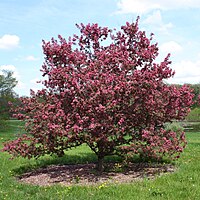
Photo from wikipedia
The wild Malus germplasm is considered as a gene reservoir for various biotic and abiotic stresses tolerance/resistance genes, including important novel horticultural traits. The dwarf vigour is considered an important… Click to show full abstract
The wild Malus germplasm is considered as a gene reservoir for various biotic and abiotic stresses tolerance/resistance genes, including important novel horticultural traits. The dwarf vigour is considered an important trait in Malus for promoting high-density plantations and enhancing productivity. Thus, an indigenous and exotic wild Malus species collected in the apple field gene bank were evaluated for their dwarfing potential, based on the diverse traits like stomatal features, photosynthetic pigments and anatomical structures. Among different parameters, inter-nodal length, root bark percentage, palisade: spongy tissue thickness ratio, xylem: phloem ratio, wood: bark ratio, vessel diameter of stem cross-section and photosynthetic pigments exhibited significant variation between dwarf and vigorous Malus species. The indigenous Himalayan crabapple—Malus baccata (L.) Borkh. (Rohru) showed the shortest inter-nodal length (23.82 ± 1.08 mm), low root bark percentage (69.30 ± 0.37), low xylem: phloem ratio (0.43 ± 0.01), low wood: bark ratio (0.49 ± 0.07), smaller xylem vessel diameter (9.67 ± 0.40 µm), and higher palisade: spongy tissue thickness ratio (1.25 ± 0.04) than the vigorous counterparts. These parameters were comparatively at par with the known dwarfing rootstock M.9. The foliar photosynthetic pigments content was significantly higher in M. baccata (Rohru) compared to other studied Malus species. Furthermore, stomatal density showed much dependence on the size of stomata, specifically its length rather than the vigour of Malus genotypes. The study revealed that Malus baccata (Rohru) had several dwarfing attributes which were comparable to the dwarfing rootstock M.9 and thus could serve as an important genetic resource for the development of indigenous dwarfing rootstock.
Journal Title: Genetic Resources and Crop Evolution
Year Published: 2021
Link to full text (if available)
Share on Social Media: Sign Up to like & get
recommendations!